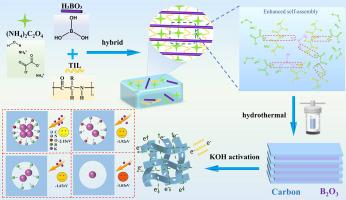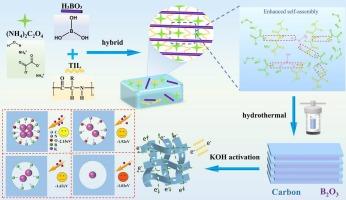A novel biomass-based NOB-rich porous carbon self-assembled into crosslinked 3D layered structures for supercapacitors
IF 13.2
1区 工程技术
Q1 ENGINEERING, CHEMICAL
引用次数: 0
Abstract
The increasing demand for sustainable energy storage solutions highlights the necessity of exploring renewable biomass materials as supercapacitor electrodes. Tamarindus indica L. (TIL) nuclei are often considered agricultural waste. Their use as electrode materials reduces waste and generates economic value. In this study, a strategy to enhance the self-assembly of TIL and H₃BO₃ by (NH4)2C2O4 under hydrothermal conditions was proposed, and the B/N/O co-doped cross-linked 3D layered porous carbon materials were successfully constructed. In this process, (NH₄)₂C₂O₄ not only acts as a nitrogen- and oxygen-enriched precursor but also stabilizes the structure during self-assembly via (NH₄)₂C₂O₄ via electrostatic adsorption and hydrogen bonding. This results in the simultaneous formation of layered pores and doped heteroatoms during pyrolysis. Subsequently, KOH disrupts and recombines the connections between carbon layers, ultimately forming a three-dimensional cross-linked layered structure. The resulting carbon materials demonstrate exceptional properties, including a heteroatom content of 16.23–20.06 at.%, a specific capacitance of 367 F g−1 at 0.5 A g−1, and a capacitance retention of 97.69 % after 10,000 cycles. The symmetrical supercapacitor maintains 92.3 % cycling stability after 10,000 cycles. Density Functional Theoretical (DFT) calculations show that high levels of N/B/O doping and fringing B, N, and oxygen-containing groups enhance their ability to adsorb and store electrolyte ions. Using a two-dimensional (2D) layered structure as a precursor enables morphological control through KOH etching and provides new insights for developing high-performance biomass-derived electrodes.


一种新型生物质基富nob多孔碳自组装成交联三维层状结构的超级电容器
对可持续能源存储解决方案日益增长的需求凸显了探索可再生生物质材料作为超级电容器电极的必要性。柽柳(Tamarindus indica L., TIL)核通常被认为是农业废弃物。它们作为电极材料的使用减少了浪费并产生了经济价值。本研究提出了一种在水热条件下利用(NH4)2C2O4增强TIL和H₃BO₃自组装的策略,并成功构建了B/N/O共掺杂交联三维层状多孔碳材料。在此过程中,(NH₄)₂C₂O₄不仅作为富氮富氧前驱体,而且通过(NH₄)₂C₂O₄通过静电吸附和氢键作用稳定了自组装过程中的结构。这导致在热解过程中同时形成层状孔隙和掺杂杂原子。随后,KOH破坏并重组碳层之间的连接,最终形成三维交联的层状结构。所得的碳材料表现出特殊的性能,包括16.23-20.06的杂原子含量 at。在0.5 a g−1时,比电容为367 F g−1,在10,000次 循环后,电容保持率为97.69 %。对称超级电容器在10,000次 循环后保持92.3 %的循环稳定性。密度泛函理论(DFT)计算表明,高水平的N/B/O掺杂和边缘的B、N和含氧基团增强了它们吸附和储存电解质离子的能力。使用二维(2D)层状结构作为前驱体,可以通过KOH蚀刻实现形态控制,并为开发高性能生物质衍生电极提供了新的见解。
本文章由计算机程序翻译,如有差异,请以英文原文为准。
求助全文
约1分钟内获得全文
求助全文
来源期刊

Chemical Engineering Journal
工程技术-工程:化工
CiteScore
21.70
自引率
9.30%
发文量
6781
审稿时长
2.4 months
期刊介绍:
The Chemical Engineering Journal is an international research journal that invites contributions of original and novel fundamental research. It aims to provide an international platform for presenting original fundamental research, interpretative reviews, and discussions on new developments in chemical engineering. The journal welcomes papers that describe novel theory and its practical application, as well as those that demonstrate the transfer of techniques from other disciplines. It also welcomes reports on carefully conducted experimental work that is soundly interpreted. The main focus of the journal is on original and rigorous research results that have broad significance. The Catalysis section within the Chemical Engineering Journal focuses specifically on Experimental and Theoretical studies in the fields of heterogeneous catalysis, molecular catalysis, and biocatalysis. These studies have industrial impact on various sectors such as chemicals, energy, materials, foods, healthcare, and environmental protection.
 求助内容:
求助内容: 应助结果提醒方式:
应助结果提醒方式:


